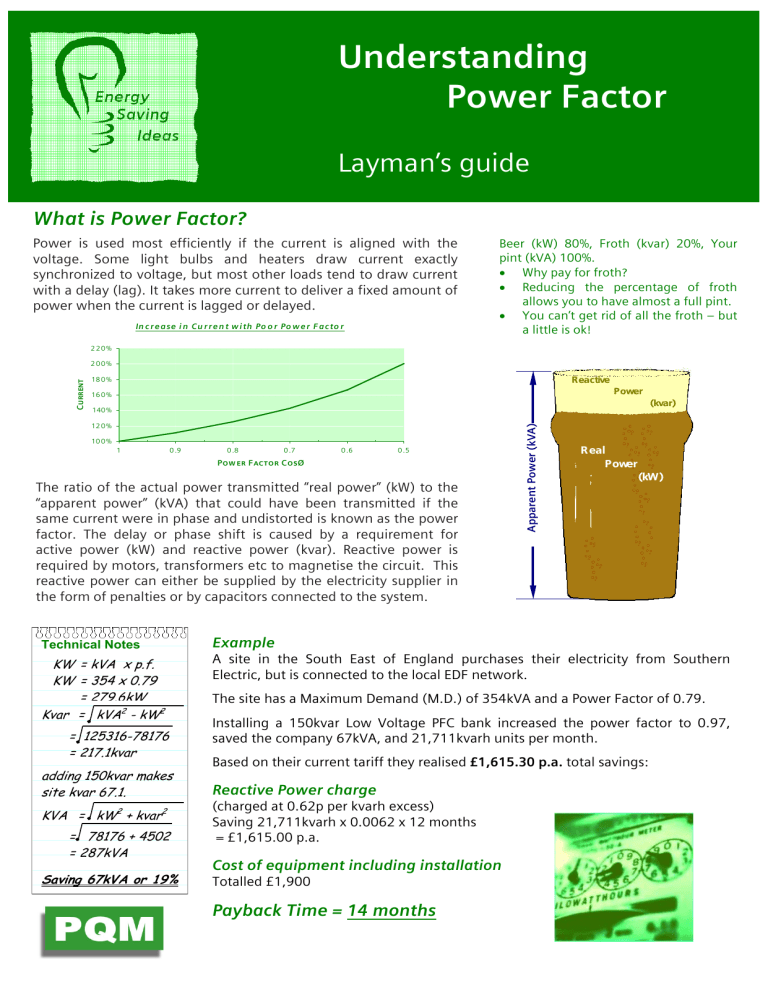Understanding Power Factor
advertisement

Understanding Power Factor Layman’s guide What is Power Factor? Power is used most efficiently if the current is aligned with the voltage. Some light bulbs and heaters draw current exactly synchronized to voltage, but most other loads tend to draw current with a delay (lag). It takes more current to deliver a fixed amount of power when the current is lagged or delayed. In c r e ase i n Cu r r e n t w i th Po o r Po w e r F ac to r Beer (kW) 80%, Froth (kvar) 20%, Your pint (kVA) 100%. • Why pay for froth? • Reducing the percentage of froth allows you to have almost a full pint. • You can’t get rid of all the froth – but a little is ok! 220% Reactive 18 0 % Power 16 0 % (kvar) 140 % 12 0 % 10 0 % 1 0 .9 0 .8 0 .7 0 .6 0 .5 Pow er Factor CosØ The ratio of the actual power transmitted “real power” (kW) to the “apparent power” (kVA) that could have been transmitted if the same current were in phase and undistorted is known as the power factor. The delay or phase shift is caused by a requirement for active power (kW) and reactive power (kvar). Reactive power is required by motors, transformers etc to magnetise the circuit. This reactive power can either be supplied by the electricity supplier in the form of penalties or by capacitors connected to the system. Technical Notes KW = kVA x p.f. KW = 354 x 0.79 = 279.6kW Kvar = kVA2 - kW2 = 125316-78176 = 217.1kvar adding 150kvar makes site kvar 67.1. KVA = kW2 + kvar2 = 78176 + 4502 = 287kVA Saving 67kVA or 19% Apparent Power (kVA) Current 200% R eal Power (kW) Example A site in the South East of England purchases their electricity from Southern Electric, but is connected to the local EDF network. The site has a Maximum Demand (M.D.) of 354kVA and a Power Factor of 0.79. Installing a 150kvar Low Voltage PFC bank increased the power factor to 0.97, saved the company 67kVA, and 21,711kvarh units per month. Based on their current tariff they realised £1,615.30 p.a. total savings: Reactive Power charge (charged at 0.62p per kvarh excess) Saving 21,711kvarh x 0.0062 x 12 months = £1,615.00 p.a. Cost of equipment including installation Totalled £1,900 Payback Time = 14 months What type of Power Factor Correction? 100% Power factor correction equipment is available in various forms and is very easily misapplied. Choosing the right type of correction is essential in getting good long-term benefit for the equipment. Standard or De-tuned? The choice of equipment is dependent upon the nature of the loads connected. If there are any non-linear loads connected these may adversely affect the equipment: Absorb harmonic currents, leading to premature failure Make the power quality for connected equipment worse. While standard PFC is approximately half the price of the equivalent de-tuned type if installed in site with a considerable amount of non-linear load its operating life is cut to months. Special PFC/ Filter Percentage of non-linear loads such as Computers, Variable Speed Drives, UPS etc. 50% De-tuned PFC 15% Standard PFC None General rules of thumb; if total non-linear load percentage exceeds 15%, detuned PFC must be used. Exceeding 50% requires a special filter. Low Voltage PFC Correction of Power factor at low voltage is the usual convention. Banks are low cost and come in a range of different types to fit the customers individual needs. Medium Voltage PFC An example of a Low Voltage (400V) PFC bank In large facilities Medium Voltage compensation may become a lower cost option. This enables one large bank to provide the compensation for a number of supplies. The PQM Difference Involved in electrical engineering since 1976, there are not many technical problems that we haven't seen. Our broad experience includes work in energy measurement, product design, installation and maintenance. This gives us a strong appreciation of our customers' needs and expectations, and also the means to meet their requirements. In recent years we have focussed on identifying, quantifying and correcting 'power quality' and 'power factor' problems; having successfully assessed and applied solutions to over 550 installations - both at Low and Medium Voltage. An example of a Medium Voltage (11kV) PFC bank Contact us: Power Quality Management Ltd PO BOX 76 Blakeney, GL15 4WU Phone: 01594 510670 Fax: 01594 516170 E-mail: info@pqmanagement.co.uk www.pqmanagement.co.uk
